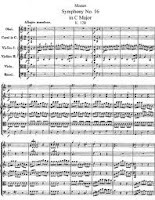"Why K.16 should ever be performed is incomprehensible," wrote the once-influential critic and refugee from Nazism, Hans Keller (above) about Mozart's first symphony (in E flat major). He thought it was completely worthless.
Following on from the point I was making at the end of my last post, this cliché-ridden first effort at symphonic form gets a heck of a lot of airings - prime-time limelight that could be better spent introducing us to the most interesting symphonic works of all those many, barely-known contemporaries of the Big Classical Three (my hero Haydn, Young Wolfie & ol' Ludwig). Yes, instead of BBC Radio 3 broadcasting Mozart's Symphony No.1 for the umpteenth time this year (and, boy, they certainly do broadcast it a lot), let's hear something more from, say, 'The Spanish Mozart' Arriaga or 'The Polish Mozart' Joseph Zeidler - or Clementi, Krommer, Pleyel, one of the Stamitzes, Gossec, Pichl, Gyrowetz, Kozeluch...er..Salieri, Wranitzky, the discoverer of Uranus Herschel, Myslivecek...and so on and so forth (as Melvyn Bragg would say).
All that said...and ignoring all those worthies...Mozart's First Symphony is a piece by an eight-year old (AN EIGHT-YEAR OLD!) who (several years later) was set to become a genius - and, for all its clichés, it's quite fun to listen to. Switch off your critical faculties, Hans, and enjoy the ride! The first movement begins with a fanfare figure answered by quiet, harmonically-shifting chords - its main theme. The second subject group is, if it makes sense to talk in this way, 'prophetic' in being a bundle of themes. The minor-key Andante potters around various harmonies without remembering to give us a tune, yet its simplicity doesn't lack listener appeal. The presto Finale has perhaps the most going for it melodically.
Now, my man Haydn's First Symphony, though aired much less often, is far superior to Mozart's - though, in fairness to Wolfgang, Joseph was 17 when he wrote it (nine years older than this young later-to-be friend). The opening Presto is in two-part (binary) form and packs its exposition with themes, starting with a rocketing main theme (p<f dynamically) across all the notes of two octaves which climaxes in horn-led fanfares. A spry melody follows, then a sparkling transition takes us to the dancing, harmonically-airborne second subject and various closing themes. This is not remotely 'prophetic' of Haydn's later tendency towards monothematicism (the use of just one theme to fill a movement). The development section is, by Haydn's standards, basic, steering various patterns into various sequences. Now, it's not great Haydn but my hunch is that it's probably as good (if not better?) than any other symphony composed in the 1750s. The following slow movement is scored for strings alone, is simple but pleasing, somewhat formal in the manner of an old, genteel dance and led by melody. Note the rhythmic surprise near the beginning of the second half and the subsequent dip into the minor. The Presto Finale comes closest to the Haydn of the future with a good tune for the strings, emboldened by the horns, and containing quacking figures (ah, Haydn's hens!), though the development section is tiny.
I won't bring up Beethoven's First Symphony (oh, I just have!), as that's a masterpiece by any standards and, thus, a very different kettle of pilchards from these two below-par efforts.



No comments:
Post a Comment